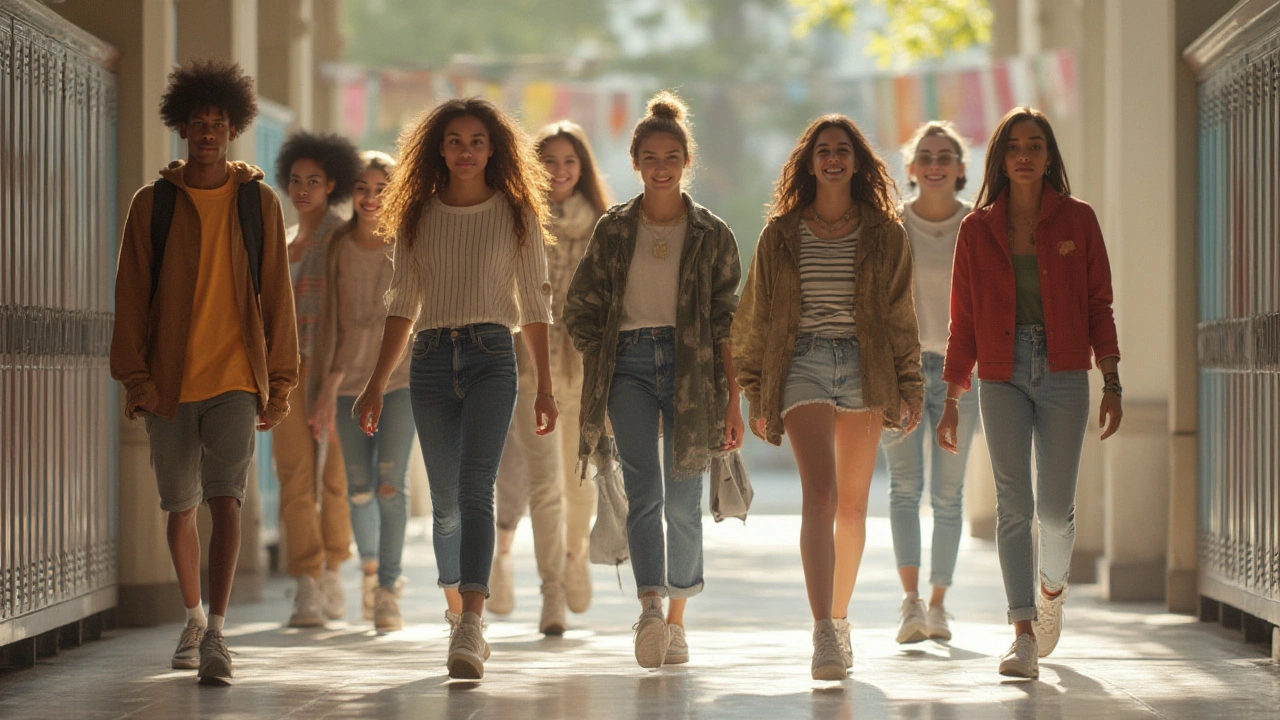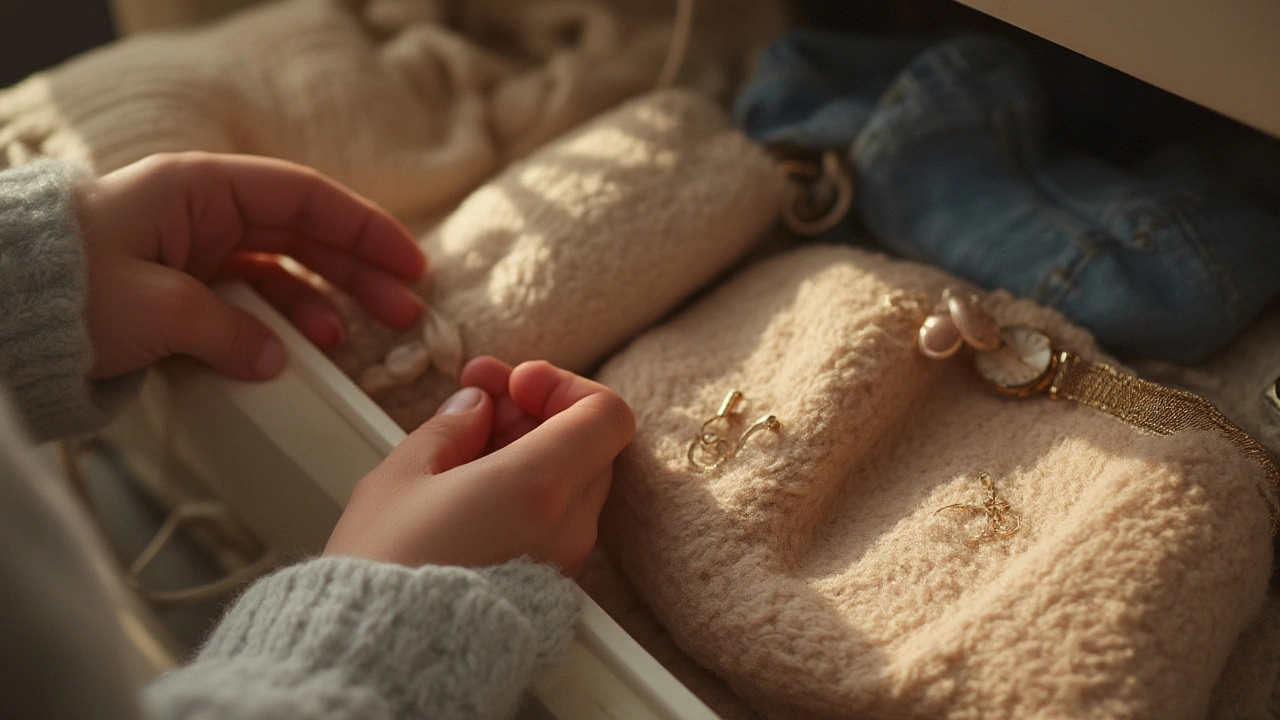How to Dress Rich in High School: Real-World Style Tips for Teens

Money talks, but you don't need a trust fund to look like you just stepped out of a G-Wagon. High school’s complicated enough without stressing over every outfit. The craziest part? Most people can't tell the difference between a $900 hoodie and a solid $30 dupe. What really sells 'rich' isn’t just the brand on your chest—it’s the details, the energy you bring, and how savvy you are about the rules of teen style right now. Want to flip the script? Stick around—because the real secret to dressing rich is more accessible than you think.
Sneaky Secrets of Looking Expensive (Without Dropping a Fortune)
First thing’s first—stop window shopping brands that could eat your summer job savings in one go. Dressing ‘rich’ at school isn’t about flexing real designer tags—it’s about smart choices that mimic the vibe. Spot the rich kids in the wild? You’ll notice the little things, like the fit of their jeans or the quality of their shoes. Here’s where you level up: focus on fit, fabrics, and subtlety.
Seriously, tailoring is the MVP. If your pants are drowning your sneakers or sleeves hang past your knuckles, you’ll look like you raided your uncle’s closet. Find a local tailor (many dry cleaners do simple adjustments cheap) and get a couple pieces fitted just for you. Suddenly, you look cleaner than anyone else in homeroom. Want to hack fabrics? Cotton, linen, and wool blends look luxe even when they’re not pricey. Synthetics get sweaty fast and can look shiny—steer clear when you can.
About logos—rich-leaning teens are ditching obvious branding for stealthy stuff. Think simple, crisp, and logo-free. According to an article in
"The New York Times reported in 2024 that minimalism and ‘quiet luxury’ are beating logo-splashed streetwear trends in high-income student circles."If you do want to rep a brand, look for ‘diffusion’ lines—like Calvin Klein’s CK line or Ralph Lauren’s Polo line. These have the right energy, but the price tags won't destroy your bank account.
Here’s a quick cheat sheet on items that always look expensive (even if they aren’t):
- Crisp white sneakers (think Adidas Stan Smiths or Nike Air Force 1s—clean is key!)
- Tailored chinos or slim jeans
- Fitted plain tees or polos—no graphics needed
- A lightweight bomber jacket or a trench coat if your climate allows
- Leather (or really good vegan) belts and wallets—choose black or brown, stay away from flashy hardware
When it comes to colors, neutrals are your BFF. Black, navy, gray, and shades of white always look smart and expensive—plus, they’re easy to match. Build a week’s worth of outfits around these, then pop in a little color—think a burgundy tee or forest green hoodie for accent.
Don’t forget about grooming. Clean nails, tidy hair, and fresh kicks instantly boost the expensive illusion. Celebrities spend way more on stylists for a reason.

How to Shop and Upgrade on a Budget—Without Looking Like You Tried Too Hard
You don’t need a fat wallet for first period to turn heads. It’s about strategy, not how deep your pockets are. The top trick? Learn where to shop. Thrift stores, consignment shops, eBay, and apps like Depop or Grailed are a goldmine. Top-shelf brands—think Supreme, Polo, or even vintage Tommy Hilfiger—end up here for a fraction of retail. If you get good at this game, you might even flip a few finds yourself for profit.
Here in Chicago, thrift hotspots in neighborhoods like Wicker Park or Lakeview often get last season’s inventory. I once found a Burberry scarf for $15—looked up the tag and the original was $350. That’s the kind of score you want. Thrift store secret: Check the men’s small and women’s large sections for best picks—lots of teens outgrow things fast and donate high-end pieces still in great shape.
But let’s talk smart new buys, too. H&M, Zara, and Uniqlo churn out pieces that copy designer looks, right down to the trim details. Buy basic, then take it to a tailor for a custom fit—money well spent. Uniqlo’s SUPIMA cotton T-shirts stay looking sharp after dozens of washes and cost about $15 apiece. Check this out:
| Brand | Average Price (T-Shirt) | Known For |
|---|---|---|
| Uniqlo SUPIMA | $15 | Quality, durability |
| Zara Basics | $18 | Trendy cuts, neutral tones |
| H&M Premium | $20 | Smooth finishes, updated fits |
Accessories separate the pros from the rookies. A simple watch (even a Timex or Casio in silver or gold tone—$20-$50 gets the job done) makes a huge impact. If you wear glasses, pick frames that suit your face shape, and keep them clean. Canvas or leather backpacks with little fuss look way richer than standard issue ones. Try swapping out plastic buttons for metal or mother-of-pearl on coats and blazers—it’s a $10 fix that can have a $100 effect.
Watch for seasonal sales—sign up for email lists (use a spam account if you hate marketing) just to get notified about flash sales and exclusive codes. If you’re patient, the right deal always lands. But avoid super trendy splurges; what’s ‘in’ in September might look tired by January.
When it comes to shoes, maintenance matters more than cost. You can fake a luxury look with $50 sneakers or thrifted loafers if they’re spotless. Grab a sneaker cleaning kit for ten bucks and commit to using it. Same goes for laces—replace ratty ones. Nothing says ‘I have money’ like always looking put-together—and nothing ruins a vibe quicker than scuffed-up shoes or a wrinkled shirt.

Confidence, Attitude, and the Little Extras Rich Kids Actually Rely On
Spotting the difference between someone flexing and someone who actually seems rich is all about attitude. Wealthy teens aren’t loud about every new thing they buy. If you stroll into class acting like you belong in the look—a little chill, a little ‘yeah, it’s just clothes’—people believe it. The trick is to show confidence, not cockiness. Good posture, making eye contact, and not fussing with your clothes all the time is clutch.
Another big tip—learn timing. 'Rich kid energy' isn’t just about material stuff. Join a club, play sports, or get involved in something outside the classroom. When people see you leading the tennis team or starring in the debate club, your style gets an automatic upgrade—social status works that way.
If you’re comfortable, find a unique piece that becomes your signature. Maybe it’s a vintage Dad hat, a favorite pair of shades, or a ring you wear every day. These little ‘extras’ make people ask where you got it, and it creates a vibe that’s hard to imitate. When someone asks about your jacket, being able to say "it’s vintage" or "I thrifted it" is cooler than rattling off a designer name.
Don’t sleep on scent, either. Most students ignore cologne—pick something clean and subtle (try Versace Dylan Blue or Nautica Voyage, both under $50) and use one spray in the morning, not a cloud. Scent memory is powerful; if people recognize you walk by, you’re already halfway to ‘main character’ status.
And let’s talk social media. Don’t flood the feed with poses and brands. Post once in a while, but keep it chill and lifestyle-focused—a photo at a coffee shop, shot of sneakers on the curb, something candid. Keep the feed as curated as your closet. That’s how it’s done by people in-the-know, not trying to show off.
Feeling lost? Here’s a checklist for instant ‘rich’ vibes:
- Stick with classic styles over trends—think blazers, simple tees, neat pants.
- Prioritize fit—tailoring is worth more than logos.
- Rotate and repeat—outfit repeats are chic if everything looks fresh.
- Invest in grooming and scent, not just clothes.
- Craft a tiny signature detail that sets you apart (but keep it personal).
Looking rich isn’t about the money—it’s about how you carry yourself. Style is the tool; confidence is the magic. Oh, and take it from the world’s best-paid stylists—simple wins every time. Why chase the hype when you can invent your own?
Alan Crierie
July 17, 2025 AT 22:21This article really brings up some interesting points about how teens can elevate their style without breaking the bank. The emphasis on confidence as a key factor in looking and feeling rich is spot on! A well-fitted outfit paired with good posture can truly transform one's presence.
I'd add that understanding your personal style is crucial too. It's not just about copying expensive trends but about adapting them to your own vibe. Plus, thrift stores and second-hand shops can be gold mines for affordable stylish pieces, often with unique character.
Overall, this guide seems practical and encouraging. Would love to hear more about how teens can balance comfort with style, especially for long school days. What do you all think about integrating personal expression with those 'rich' style hacks?
Zelda Breach
July 21, 2025 AT 21:05Honestly, I find the whole "dress rich" mentality kind of toxic. Why should appearance be the measure of status, especially in high school? It's perpetuating superficial values and I doubt it really helps anyone develop genuine confidence.
Not to mention, the obsession with brands and 'looking expensive' often leads to a lot of pointless consumerism. Teens should focus on cultivating skills, kindness, and character rather than trying to appear wealthy through clothes.
Sure, dressing well matters, but it doesn't have to scream "I'm rich" to be effective. Smart advice would prioritize authenticity over superficiality. This article misses that nuance completely.
Nicholas Zeitler
July 25, 2025 AT 19:48I appreciate the proactive stance of this post! Teens really need to understand that style isn’t about flashy labels but about elevating what they already have. Simple upgrades, like wearing clean shoes and well-maintained clothes, can work wonders!
Also, confidence is the secret sauce! Make eye contact, smile, and own your outfit. That’s what makes people perceive you as put-together. And yes, it’s a skill that needs practice.
One thing I’d recommend is paying attention to grooming too—hair, nails, and hygiene complement any outfit. It’s all about presenting a polished version of yourself in every detail.
Denise Young
July 29, 2025 AT 18:31While the post tries to be motivational, I can't help but notice it glosses over the socio-economic reality many teens face. Fashion is a form of self-expression, yes, but this constant pressure to look 'rich' is a double-edged sword, especially when 'affordable upgrades' sometimes still mean disposable income people don't have.
However, if approached carefully with an understanding of style fundamentals—like fit, fabric quality, and subtle details—it can become an empowering tool rather than a shallow facade.
It’d be great to see more emphasis on educating teens about sustainable fashion choices and how to build a timeless wardrobe rather than chasing trends that scream luxury.
k arnold
August 2, 2025 AT 17:15Oh sure, just throw a bunch of "smart upgrades" at high schoolers and magically they'll look like they just stepped off a yacht. Because apparently the secret to status is tight jeans and a firm handshake, right? Please.
If you think dressing 'rich' is really about clothes, you’ve missed the entire point of real wealth—which, spoiler alert, can’t be bought on clearance racks or hacked by Instagram filters.
At the end of the day, teens should probably worry less about their label and more about what they're actually learning and doing. Maybe even what they’re reading besides style blogs!
lucia burton
August 6, 2025 AT 15:58When we talk about dressing with the aura of affluence in a high school environment, it’s critical to dissect the semiotics of visual presentation. The discourse often neglects the underlying semiotic markers that signal socio-economic status.
The article’s suggestions on affordable hacks are undoubtedly pragmatic, yet they skirt the deeper narratives of class performativity and identity construction in adolescent spheres. The layering of textures, the nuances in cut, the interplay of monochrome palettes—these are aesthetic considerations that transcend mere label recognition, enriching the sartorial lexicon of any teen.
Encouraging teens to engage with fabric quality, tailoring techniques, and subtle brand cues could cultivate a more profound and dizzying sense of style sophistication, rather than surface-level mimicry.
Tiffany Ho
August 10, 2025 AT 14:41I really liked this post! It’s refreshing to see advice that encourages confidence and smart style choices without insisting you buy expensive stuff to look good. Just focusing on keeping your clothes neat and pairing things well can make a huge difference.
And it’s so true that confidence changes everything. You can rock any outfit when you feel good about yourself. Also, little things like clean shoes and matching colors go a long way. I hope more teens see that you don’t need to break the bank to look put together.
Do you think this kind of advice can help younger kids pick up positive habits about self-presentation early on?
Sam Rittenhouse
August 14, 2025 AT 13:25Reading through these tips, I was struck by how much style in adolescence can shape self-esteem and social inclusion. It’s not just about the clothes but what they represent to a teen navigating identity.
While appearance can be superficial, it’s a language teens use to communicate who they are or want to be. Learning to 'dress rich' in a practical sense might also teach valuable lessons in self-care, resourcefulness, and creativity. That positive skillset can translate beyond fashion into confidence in other aspects of life.
Would love to see more community-based advice on sustainable styling approaches that encourage collaborative sharing or upcycling rather than only individual consumption.
michael Melanson
August 15, 2025 AT 11:55This is quite a practical piece. Dressing 'rich' doesn’t have to be about spending loads of cash but rather feeling comfortable and confident in your clothes. Casual doesn’t mean sloppy, and clean basics can make a huge difference.
Also, simplicity is underrated. Sometimes over-accessorizing or chasing every trend can ruin the intended polished look. Minimalism has a charm that often looks refined.
I think combining this with good grooming habits and being mindful of how you carry yourself is the real game changer. Anyone else try this approach with success?
Teja kumar Baliga
August 16, 2025 AT 10:41Such an interesting topic! In my experience, the idea of dressing well to convey status is somewhat universal but also very culturally textured. Different places have different signs and symbols of 'rich dressing'.
For teens, I encourage looking at style as a form of self-expression rather than a competitive tool. The article's mention of confidence really hits the nail on the head since style without confidence doesn't carry far.
Also, affordable upgrades are definitely smart ideas, especially if you can support local designers or sustainable brands. What are some favorite tips or hacks you all have learned about dressing well but within a budget?